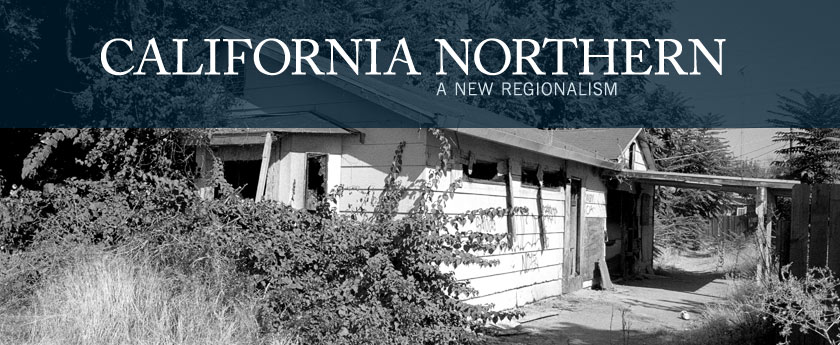The Central Valley Islands
By Richard Mills
When we imagine a city, there’s something definite, often nature-bound about its borders: Manhattan is an island, San Francisco a peninsula; Chicago and Boston hug important bodies of water. Populations nestle into habitable spots and we draw circles around them. The city we imagine has a periphery that builds steadily to a center—buildings rise and lights brighten as we move toward its peaks.
The cities in California’s Great Central Valley are not the cities we imagine. They are flat, low, and wide. Bound geographically by nothing but farmland and distant foothills, these towns tend to puddle onto the dry valley floor, with bent fingers of city trickling out onto the surrounding land. There is no clear path toward a center—you find yourself passing a shopping mall, a residential neighborhood, then driving down some huge, lonely, brightly lit avenue past a golf course and another mall. Some people experience these cities’ sprawl as placelessness. There’s “nothing there,” “no culture.” Others enjoy these cities exactly as they were intended to—as comfortable places where middle-class people can afford space and children, which, in those cities we imagine, too often seem to be luxuries reserved for the wealthy.
What gives the valley cities their character is, in part, the way their borders expanded over the past couple of decades—what land they annexed, how much acreage they swallowed up, and how fast they did it. The story of this recent growth is now a familiar one. Housing prices kept rising, developments sprang up everywhere, and cities redrew borders around them to get a slice of the property taxes that new residents brought. Some people made a lot of money; others bought nice new houses. Then, after a 2006 peak in housing prices, things started to go south. In the wake of the crash, people lost their homes and the cities lost tax revenues. Because so many of the newer residents were commuting to Bay Area jobs, this all went down in cities that were already becoming unbalanced. Too many people lived in these places and not enough worked in them. They had become big, insolvent, and unattractive.
We now associate this period of our history with hubris and appetite, and the lessons we’ve learned are mostly about the perils of overconsumption and unchecked growth—so much so that it’s easy to overlook that which was left behind during those flush years. There are, however, communities scattered throughout Central Valley cities that weren’t taken along on that dramatic rise and fall. Perhaps the most striking among them are neighborhoods—often low income, often densely populated, often Latino—that watched cities grow around them, annexing whiter, richer, or emptier land on all sides like some conscious blob. It was a long-term trend that accelerated during the boom years and left these “island” communities—neighborhoods within city boundaries but on pockets of unincorporated county land—without the basic services many Americans have come to expect as natural, indelible features of modern life, as reliable and necessary as the rising sun.
Island communities often can’t hook up to city sewers, so residents bathe in the yard, and kids get sick from playing near the saturated, sixty-year-old septic tanks. Most islands don’t have sidewalks, so people have to walk in the road—pedestrian fatality rates are high, especially among children. Island residents have no representation in city government and can’t vote in city elections, so they’re unable to influence the municipalities that they are geographically within. County sheriffs, rather than nearby city police, might have to travel through the city to get to an island, and crime rates can be high. While some residents liken the conditions to the developing countries they left, these neighborhoods can be altogether pleasant places despite their problems. Others are frightening. There are over one hundred of them in modern California cities like Fresno, Visalia, and Modesto.
Some see the islands’ existence as a strange accident of Central Valley history, a story not of exclusion but of cities growing, as they often do, in unintentional ways. There are others, however, who argue that the islands are no accident at all, but instead result from years of persistent and unacknowledged institutional racism. In one Central Valley city, island residents have filed a major civil rights lawsuit alleging just that. These residents intend to prove that city and county governments designed complex and racist bureaucratic mechanisms to steer resources away from Latino neighborhoods and maintain their exclusion from the city.
In addition to the lawsuit, some island communities are organizing themselves, learning how to navigate the intricacies of their local governments in order to piece together enough funding to improve conditions in their neighborhoods. And after months, years—and in some cases, decades—of work, they’re beginning to see signs of progress.
This is an excerpt of “The Central Valley Islands”

